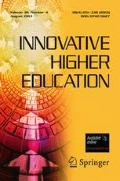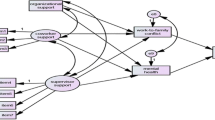Abstract
This study of 276 couples compares coworking couples, which means both partners work for the same university, with noncoworking couples, those couples in which only one partner is employed at a university. Among the employees at the two universities studied, one in seven dual-earner couples cowork. These couples are more educated and are less likely to prioritize one spouses' career over that of the other, as compared to noncoworking couples. Coworking is positively associated with work commitment and family success for husbands and with family and marital satisfaction for wives, especially for couples with graduate degrees. Findings suggest that employment of spouses can be beneficial to employees and institutions.
Similar content being viewed by others
References
Astin, H. S., & Milem, J. F. (1997). The status of academic couples in U. S. institutions. In M. A. Ferber & J. W. Loeb (Eds.), Academic couples: Problems and promises (pp. 128–155). Chicago: University of Illinois.
Becker, P. E., & Moen, P. (1999). Scaling back: Dual-earner couples' work–family strategies. Journal of Marriage and the Family, 61, 995–1007.
Bielby, W. T., & Bielby, D. D. (1992). I will follow him: Family ties, gender-role beliefs, and reluctance to relocate for a better job. American Journal of Sociology, 97, 1241–1267.
Blossfeld, H.-P., & Drobnic, S. (2001). Careers of couples in contemporary societies. Oxford: Oxford University Press.
Burke, D. L. (1988). A new academic marketplace. New York: Greenwood Press.
Christensen, K. E., & Gomory, R. E. (1999, June 2). Three jobs, two people. Washington Post, A21.
Collins, E. G. C. (1983). Managers and lovers. Harvard Business Review, 61, 142–153.
Creamer, E., & Associates (2001). Working equal: Academic couples as collaborators. New York: Routledge Falmer.
Ferber, M., & Hoffman, E. S. (1997). Are academic partners at a disadvantage? In M. Ferber & J. W. Loeb (Eds.), Academic couples: Problems and promises (pp. 182–207). Chicago: University of Illinois Press.
Ferber, M., & Loeb, J. W. (Eds.) (1997). Academic couples: Problems and promises. Chicago: University of Illinois Press.
Hays, S. (1996). The cultural contradictions of motherhood. New Haven, CT: Yale University Press.
Hertz, R. (1986). More equal than others: Women and men in dual-career marriages. Berkeley, CA: University of California Press.
Hochschild, A. (1989). The second shift. New York: Avon Books.
Hochschild, A. (1997). The time bind: When work becomes home and home becomes work. New York: Metropolitan Books.
Hornig, L. S. (1997). Academic couples: The view from the administration. In M. A. Ferber & J. W. Loeb (Eds.), Academic couples: Problems and promises (pp. 248–269). Chicago: University of Illinois Press.
Lobel, S. A., St. Claire, L., Quinn R. E., & Warfield, A. (1994). Love without sex: The impact of psychological intimacy between men and women at work. Organizational Dynamics, 23, 5–16.
Mainiero, L. A. (1993). Dangerous liasons?A review of current issues concerning male and female romantic relationships in the workplace. In E. Fagenson (Ed.), Women in management (pp. 165–185). Newbury Park, CA: Sage.
McNeil, L., & Sher, M. (1999). Dual science career couples. Retrieved August 20, 2003, from http://physics.wm.edu/∼sher/survey.pdf
Milem, J. F., Sherlin, J., & Irwin, L. (2001). The importance of collegial networks to college and university faculty. In E. Creamer and Associates (Ed.), Working equal: Academic couples as collaborators (pp. 146–166). New York: Routledge Falmer.
Moen, P. (Ed.)(2003). It's about time. Ithaca, NY: Cornell University Press.
Moen, P., & Sweet, S. (2002). Two careers one employer: Couples working for the same corporation. Journal of Vocational Behavior, 61, 466–483.
Moen, P., Sweet, S., & Townsend, B. (2001). How family friendly is upstate New York? Ithaca, NY: Cornell Careers Institute.
Pingree, S., Butler, M., Paisley, W., & Hawkins, R. (1978). Anti-nepotism's ghost: Attitudes of administrators toward hiring professional couples. Psychology of Women Quarterly, 3(1), 22–29.
Rapp, E. (1992, February). Dangerous liasons. Working Woman, 56–61.
Reed, C. M., & Bruce, W. M. (1993). Dual-career couples in the public sector: A survey of personnel policies and practices. Public Personnel Management, 22, 187–199.
Shelton, B. A. (1992). Women, men and time. New York: Greenwood Press.
Shoben, E. (1997). From antinepotism rules to programs for partners: Legal issues. In M. A. Ferber & J. W. Loeb (Eds.), Academic couples: Problems and promises (pp. 226–247). Chicago: University of Chicago Press.
Smart, M. S., & Smart, R. C. (1990). Paired prospects: Dual career couples on campus. Academe, 76, 23–27.
Werbel, J. D., & Hames, D. S. (1992). Are two birds in the hand worth more than one in the bush: The case of paired employees. Human Resource Management Review, 2, 317–328.
Werbel, J. D., & Hames, D. S. (1996). Anti-nepotism reconsidered: The case of husband and wife employment. Group and Organization Management, 21, 365–379.
Wexler, J. (1982). Husbands and wives: The uneasy case for antinepotism rules. Boston University Law Review, 62, 75–142.
Wilson, R. (1996, September 20). Weary of commuter marriages, More couples in academe make career sacrifices to be together. Chronicle of Higher Education, 43, A10-A13.
Wilson, R. (1998, April 17). When officemates are also roommates. Chronicle of Higher Education, 44, A12-A14.
Wolf-Wendel, L. E., Twombly, S., & Rice, S. (2000). Dual career couples: Keeping them together. Journal of Higher Education, 71, 291–321.
Wolkenbreit, R. (1997). In order to form a more perfect union: Applying no-spouse rules to employees who meet at work. Columbia Journal of Law and Social Problems, 31, 119–165.
Author information
Authors and Affiliations
Rights and permissions
About this article
Cite this article
Sweet, S., Moen, P. Coworking as a Career Strategy: Implications for the Work and Family Lives of University Employees. Innovative Higher Education 28, 255–272 (2004). https://doi.org/10.1023/B:IHIE.0000018909.62967.b5
Issue Date:
DOI: https://doi.org/10.1023/B:IHIE.0000018909.62967.b5




